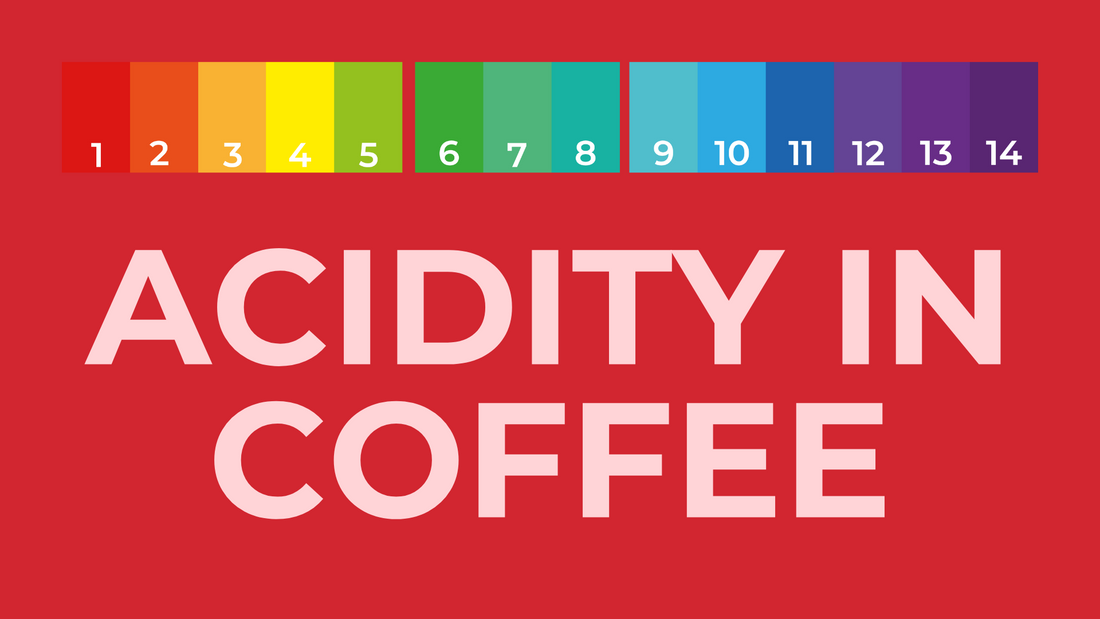
Acidity in Coffee
Share

A universally known fact is that coffee is acidic, but what many do not know is that this acidity is what makes your morning cup of joe so enjoyable. The acids within coffee are what make up those bright and tart flavors you have come to know and love.

In coffee there are two different types of acidity: organic and chlorogenic acids.

Organic Acid
The organic acids found within coffee are where the majority of the bright and bold flavors come from.
-
Citric Acid
- Citric acid is another flavor enhancing acid found in coffees that bring out fruit-forward and citrus flavors. Lighter roasts tend to have a higher concentration of citric acid while darker roasts have less.
-
Malic Acid
- Malic acid is an alpha hydroxy acid found within coffee after roasting that brings out tart, apple/pear-like complexity.
-
Acetic Acid
- Opposite to the other acids, Acetic acid is normally created in the processing and roasting phases. This acid is where the description of a “clean cup” comes into play.
Chlorogenic Acid
This acid plays a huge role in the flavor profile of your coffee. The group of polyphenolic compounds enhance the bright and fruity notes within the roast. During the roasting process, the chlorogenic acid creates byproducts of quinic and caffeic acids.
- Caffeic acids bring out brightness and flavor complexity
- Quinic acids contribute to the bitterness in a roast

Chlorogenic acid (CGA) is the primary antioxidant linked to the health benefits found in coffee. Coffees with a high CGA percentage have been linked to:
- Prevention of cardiovascular disease: high CGA coffee can help improve postprandial blood flow and endothelial function – essentially reducing the risk of cardiovascular disease and atherosclerosis.
- Reduce inflammation: can help lower inflammation levels and prevent chronic disease.
- Improve glucose regulation: can help regulate glucose levels
- Lower blood pressure: can help by creating a statistically moderate reduction in diastolic and systolic blood pressure during the ingestion period.

Why are darker roasts lower in acidity?
Dark roasts are lower in acidity simply because the beans are roasted for longer. A light roast is known for having bright or citrusy notes because they hold on to the acids previously mentioned.
This is because a darker roast undergoes the roasting process for significantly longer than a light or medium roast. This strips away a lot of the acids that a light roast holds onto. This is where the nuttier and chocolatier flavors found in a dark roast come from. The longer the coffee beans stay in the roaster, the lower the acidity that the coffee is.

When roasting, light roast beans are roasted until the “first crack” which is an audible cracking noise that sounds like popcorn popping. A medium roast will roast a tad longer, and a dark roast will sometimes go for as long as the “second crack.” As the beans continue to heat up and continue to roast, the flavor profile further develops.

How to make lower acidity coffee:
Some coffee drinkers have reported claims of stomach issues and heartburn from the acidity found within coffee. If you’re looking for a way to make your coffee a little lower in acidity when brewing at home, here’s some easy switches you can make at home:

1. Cold Brew
Cold Brew is an easy way to brew your coffee that cuts back on the acidity. The lower temperature and longer steeping time of the cold brewing process take out some of the acids that cause irritation without compromising the flavor. The cold brew maker extracts fewer acids and oils because the slower and colder process reduces the Chlorogenic Acid breakdown resulting in the smoother and more mellow flavor often associated with cold brew.

2. Salt
A trend that originated in Hue, Vietnam has become known now as an easy fix for the problem of highly acidic coffee. By adding salt to your coffee, whether it be espresso or brewed coffee, you can cut the acidity. This is because the sodium ions in salt neutralize the bitter taste of the acids in coffee. For example, when someone adds salt to their fruits or desserts (think salted caramel), it brings out the natural sweetness that already exists. The amount of salt needed to curb the acidity in coffee, it’s suggested to add a couple of dashes of salt (roughly ¼ teaspoon) to your cup.

3. Adding Milk
A simple way to negate the bitter acids that are known for causing the occasional upset stomach and heartburn is by adding milk. While dairy milk is best for cutting these acids due to the higher calcium percentage, any milk will do the job. This is because calcium cuts the pH level of coffee down.
While there are many options and resources for lowering the acidity in coffee, there’s no way to completely rid your coffee of the naturally occurring acids. In many ways, the acids in coffee get a bad rap, mostly due to a misunderstanding of the benefits and flavors that they bring to a roast. However, the acid in your coffee is what makes your cup unique! They are responsible for the exciting and bold flavors you find in your roasts. Here at Alma Coffee, we love our acids (in moderation)!





